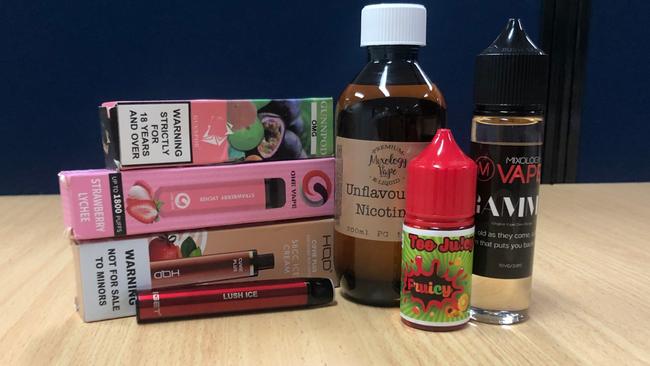Vape lab test: No wonder nicotine hooks teens
All but one of the e-cigarettes The Oz sent to be independently tested had nicotine in them. Not a single one said it contained the addictive chemical on the packet.

A flagrant black market is selling vapes and e-cigarettes containing nicotine to young people in plain sight of authorities and in contravention of the law, exposing a new generation to the highly addictive substance.
Nearly all store-bought vapes contain the chemical nicotine, despite not stating so on the packaging, threatening to undo decades of public health campaigning on the dangers of smoking.
Health experts said the true toll of vaping may not be known for years as convenience stores and tobacconists continue to sell vapes with near impunity.
Tobacconists in inner Sydney sold The Oz vapes without asking for proof-of-age identification or a valid prescription for nicotine e-cigarettes, which is a requirement by law.
None of the vapes said they contained nicotine on the packaging and only one tobacconist said that the vape they sold The Oz contained nicotine, an IGET Shion Pod. They did not ask for a prescription.
Independent testing by the University of Wollongong (UOW) confirmed all but one of the four store-bought vapes – a strawberry lychee flavoured One Vape – contained the highly addictive chemical.
Dr Celine Kelso said the UOW’s School of Chemistry has tested hundreds of vapes. She said all contained nicotine except for the one supplied by The Oz.
“That’s the first vape out of 350 that we’ve seen without nicotine in it,” said Dr Kelso.

Dr Kelso said a lot of young people likely vaped without realising the products contained nicotine and were becoming hooked on the highly addictive substance.
“A lot of them probably don’t even know that they will be getting hooked because the product themselves don’t have nicotine,” she said.
“So they’re assuming it's just flavoured water or something innocent but they end up being highly addicted to a product in the first case they probably shouldn’t have touched.”
Aidan Rider, 18, said he’d been vaping for about three years after first trying them at school.
“I get up in the morning and the first thing I think of is I need a morning heady (head spin),” said Mr Rider, adding he hadn’t been a cigarette smoker before he became hooked on vaping.
Health effects from vaping
University of Sydney toxicology expert Professor Jody Moller said the concentration of carcinogens in vapes was lower than in cigarettes but said other health impacts, such as from inhaling coolant, were unknown.
“We don’t know what is happening when people are inhaling these compounds,” she said.
“They’ve never been designed for inhalation before.
“Most of them are considered safe for consumption in foods [but] there really is very little data on inhalational toxicity.”
There have been a number of cases of collapsed lungs linked to vaping in the United States and health authorities in 2018 identified a new condition called E-cigarette or Vaping Associated Lung Injury.
Australian Medical Association vice president Danielle McMullen said the long term effects of vaping were unknown but it was well established that nicotine was a toxic and addictive substance.
Dr McMullen said vapes, which are brightly coloured and often sweetly flavoured, were quite clearly marketed towards children.
“We’re seeing alarming rates of vaping in school aged children and have significant concerns on how that affects their development and that it could be triggering a new generation of people addicted to nicotine,” she said.
Rates of smoking in Australia have steadily fallen since public health bodies first began campaigning about the health consequences of cigarettes in the early 1970s and the smoking rate halved between 1995 and 2019 to 13%, according to the National Drug Strategy Household Survey.
University of Sydney emeritus professor in public health Simon Chapman, a longtime campaigner against big tobacco, said the prevalence of smoking among teenagers had never been lower before the emergence of vapes.
“From the perspective of a tobacco company or tobacco industry, they would see that as an absolute disaster and the imminent death of their industry if they don’t get a cohort of young people using their products,” he said.
“They are absolutely desperate to somehow get a grip on young people again and all of the tobacco companies are now in the vaping business without exception.”
Health Minister Mark Butler said the previous coalition government had dropped the ball on vaping and the rate of young people vaping had nearly doubled between 2016 and 2019 to 5.3%.
“Our government is concerned about the increased marketing and use of e-cigarettes, particularly among young people,” he said.
“Labor has a proud history of implementing world leading anti-smoking policies including plain packaging laws which have seen a steep reduction in tobacco consumption since 2012.”


